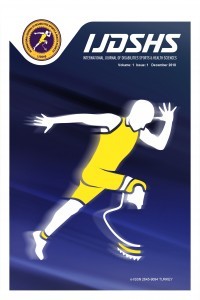Investigation of the Foot Arch Postures of Sport Sciences Students According to Some Variables
Investigation of the Foot Arch Postures of Sport Sciences Students According to Some Variables
Arc, Foot posture, Pes planus, Pes cavus, Student Sports,
___
- Açak, M., Özen, G. & Tan, E. (2023). Investigation of foot posture and body composition in 10-14 years old children: The Case of Çanakkale Ezine District. Iğdır University Journal of Sport Sciences, 6(1), 45-56.
- Açak, M. (2020). The effects of individually designed insoles on pes planus treatment. Scientific Reports, 10(1), 19715.
- Akgönül, E. K., & Yıldırım, U. C. (2021) Investigation of the relationship between anthropometric characteristics and strength values of star cyclists. Sporty Overview: Journal of Sport and Education Sciences, 8(3), 391-408. Aktan, A. K., & Kutlay, Ö. (2022). The relationship between body mass index and pes planus, balance, quality of life and pain levels in sedentary women and men. Value in Health Sciences, 12(1), 58-64.
- Aminian, A., & Sangeorzan, B. J. (2008). The anatomy of cavus foot deformity. Foot and ankle clinics, 13(2), 191-198.
- Atak, E., Özbek, H., & Algun, Z.C. (2016). The effect of body weight gain on foot posture and knee pain in healthy sedentary individuals. Journal of Exercise Therapy and Rehabilitation, 3(2), 66-71.
- Azhagiri, R., Malar, A., Hemapriya, J., & Sumathi, G. (2021). The cause and frequency of PES Planus (Flat Foot) problems among young adults. Asian Journal of Medical Sciences, 12(7).
- Buldt, A. K., Allan, J. J., Landorf, K. B., & Menz, H. B. (2018). The relationship between foot posture and plantar pressure during walking in adults: A systematic review. Gait & posture, 62, 56–67.
- Carr, J. B., Yang, S., & Lather, L. A. (2016). Pediatric pes planus: a state-of-the-art review. Pediatrics, 137(3).
- Carvalho, B. K. G., Penha, P. J., Penha, N. L. J., Andrade, R. M., Ribeiro, A. P., & João, S. M. A. (2017). The influence of gender and body mass index on the FPI-6 evaluated foot posture of 10- to 14-year-old school children in São Paulo, Brazil: A cross-sectional study. Journal of Foot and Ankle Research, 10, 1.
- Dilekçi, U. (2023). Conceptual Foundations of Sport-8: Physical Fitness-Physical Development 29-42. Istanbul: Efe Akademi Publishing. E-ISBN: 978-625-6504-56-1
- Fabry, G. (2010). Clinical practice. Static, axial, and rotational deformities of the lower extremities in children. Eur J Pediatr. 169(5), 529-34.
- Korkmaz, M. F., Acak, M., Duz, S., & Bozduman, O. (2020). Prevelance of flatfoot in secondary school students and its relationship with obesity. Medicine, 9(2), 298-304.
- Kazdal-Kabakulak, H. (2015). Investigation of pes planus prevalence in primary schoolchildren of Fatih district (Published medical speciality thesis). Istanbul University Cerrahpaşa Faculty of Medicine, Department of International Medicine and Rehabilitation. Istanbul, 91p, (in Turkish).
- Michelson, J. D., Durant, D. M., & McFarland, E. (2002). The injury risk associated with pes planus in athletes. Foot & ankle international, 23(7), 629-633.
- Mølgaard, C., Lundbye-Christensen, S., & Simonsen, O. (2010). High prevalence of foot problems in the Danish population: a survey of causes and associations. The foot, 20(1), 7-11.
- Nalbant, A. (2014). Investigation of the effect of daily activities on foot posture and plantar pressure (Published master thesis), Dokuz Eylül University Institute of Health Sciences, İzmir, 48p, (in Turkish).
- Özçadırcı, A., Öztürk, F., Cinemre, A., & Kınıklı, G. İ. (2021). Does foot posture differ according to gender and lower extremity muscle strength in pre-adolescent swimmers?. European Journal of Human Movement, 46, 95-102.
- Smith, R. E., Lichtwark, G. A., & Kelly, L. A. (2021). The energetic function of the human foot and its muscles during accelerations and decelerations. The Journal of experimental biology, 224(13),jeb242263..https://doi.org/10.1242/jeb.242263.
- Staheli, L. T., Chew, D. E., & Corbett, M. (1987). The longitudinal arch. J Bone Joint Surg Am, 69(3), 426-428. Statler, T. K., & Tullis, B. L. (2005). Pes cavus. Journal of the American Podiatric Medical Association, 95(1), 42-52.
- Stolzman, S., Irby, M. B., Callahan, A. B., & Skelton, J. A. (2015). Pes planus and paediatric obesity: a systematic review of the literature. Clinical obesity, 5(2), 52-59.
- Troiano, G., Nante, N., & Citarelli, G. L. (2017). Pes planus and pes cavus in Southern. Annali dell'Istituto superiore di sanita, 53(2), 142-145.
- Yeagerman, S. E., Cross, M. B., Positano, R., & Doyle, S. M. (2011). Evaluation and treatment of symptomatic pes planus. Current opinion in pediatrics, 23(1), 60-67.
- Yüksel, H. B. (2015). Investigation of foot posture, functions and physical activity level in young individuals. (Published master thesis), Istanbul Medipol University Institute of Health Science, Istanbul, 105p, (in Turkish).
- Yayın Aralığı: Yılda 3 Sayı
- Başlangıç: 2018
- Yayıncı: Nevzat DEMİRCİ
Mehmet Onur SEVER, Mehmet SÖYLER, Yunus Emre ÇİNGÖZ, Emrah BARKIN
Investigation of the Effect of Playing Sports on Social Appearance Anxiety
Zeynep Senem SÖYLEYİCİ ÖCAL, Recep Fatih KAYHAN
The Effect of Personality Factors on Social Appearance Anxiety and Life Satisfaction
Evaluation of FMS Scores of Competitive CrossFit Athletes by Gender
An Overview of Paralympic Sport from a Historical and Psychosocial Perspective
Fikret SEÇEN, Fethi ARSLAN, Mehmet Akif ZİYAGİL
Üstün TÜRKER, Mustafa Barış SOMOĞLU, Efecan TEZCAN, Mine KOÇ
